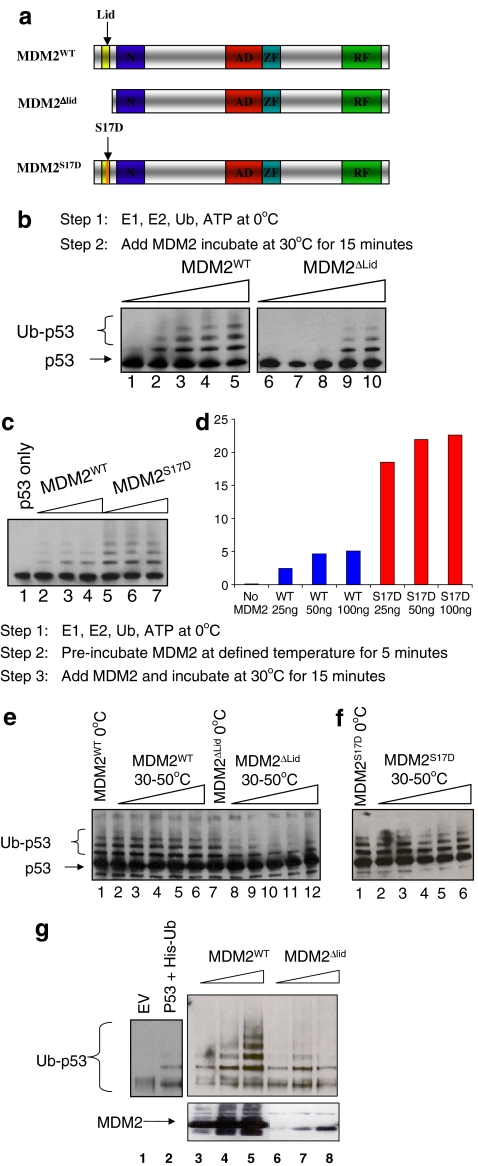Fig. 3.
A phospho-mimetic substitution in the MDM2 lid stimulates the E3 ubiquitin ligase function of MDM2. a Diagram of the functional domains of MDM2, including (1) wt-MDM2; (2) MDM2ΔLID, which has a deletion of the flexible motif; and (3) MDM2S17D, which has a phospho-mimetic aspartate mutation at Ser17 (S17D). b MDM2-pseudo-substrate motif deletion reduces the specific activity of MDM2. Purified wt-MDM2 or MDM2ΔLID was titrated directly into ubiquitination reactions using p53 as a substrate. After 10 min, the reactions were stopped and processed for immunoblotting to measure extents of p53 ubiquitination. c The S17D mutation in the MDM2 pseudo-substrate motif stimulates its E3 ubiquitin ligase function. Purified wt-MDM2 (lanes 2–4) or MDM2S17D (lanes 5–7) were titrated directly into ubiquitination reactions using p53 as a substrate. After 10 min, the reactions were stopped and processed for immunoblotting to measure extents of p53 ubiquitination, which is quantified in d. e MDM2-pseudo-substrate motif deletion promotes thermoinstability in MDM2. Purified wt-MDM2 or MDM2ΔLID was added directly to ubiquitination reactions (lanes 1 and 7) or was preincubated at increasing temperatures (0–50 °C) in ubiquitination buffer (lanes 2–6 and 8–12) followed by titration in ubiquitination reactions using p53 as a substrate. After 10 min, the reactions were stopped and processed for immunoblotting to measure extents of p53 ubiquitination. f S17D mutation in the MDM2 pseudo-substrate motif does not destabilize MDM2. Purified MDM2S17D was preincubated at increasing temperatures (0–50 °C) in ubiquitination buffer followed by titration in ubiquitination reactions using p53 as a substrate. After 10 min, the reactions were stopped and processed for immunoblotting to measure extents of p53 ubiquitination. g MDM2-pseudo-substrate motif deletion promotes MDM2 instability in cells. P53 was co-transfected into cells with his-tagged ubiquitin and vector control (lane 2) or increasing amounts of MDM2 (lanes 3–5) or MDM2ΔLID (lanes 6–8). The reactions were processed to measure p53 ubiquitination as indicated [39]

